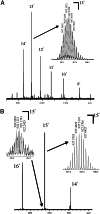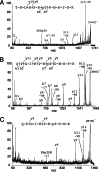Combined top-down and bottom-up proteomics identifies a phosphorylation site in stem-loop-binding proteins that contributes to high-affinity RNA binding
- PMID: 16492733
- PMCID: PMC1413926
- DOI: 10.1073/pnas.0511289103
Combined top-down and bottom-up proteomics identifies a phosphorylation site in stem-loop-binding proteins that contributes to high-affinity RNA binding
Abstract
The stem-loop-binding protein (SLBP) is involved in multiple aspects of histone mRNA metabolism. To characterize the modification status and sites of SLBP, we combined mass spectrometric bottom-up (analysis of peptides) and top-down (analysis of intact proteins) proteomic approaches. Drosophilia SLBP is heavily phosphorylated, containing up to seven phosphoryl groups. Accurate M(r) determination by Fourier transform ion cyclotron resonance (FTICR)-MS and FTICR-MS top-down experiments using a variety of dissociation techniques show there is removal of the initiator methionine and acetylation of the N terminus in the baculovirus-expressed protein, and that T230 is stoichiometrically phosphorylated. T230 is highly conserved; we have determined that this site is also completely phosphorylated in baculovirus-expressed mammalian SLBP and extensively phosphorylated in both Drosophila and mammalian cultured cells. Removal of the phosphoryl group from T230 by either dephosphorylation or mutation results in a 7-fold reduction in the affinity of SLBP for the stem-loop RNA.
Conflict of interest statement
Conflict of interest statement: No conflicts declared.
Figures




Similar articles
-
Interaction of the histone mRNA hairpin with stem-loop binding protein (SLBP) and regulation of the SLBP-RNA complex by phosphorylation and proline isomerization.Biochemistry. 2012 Apr 17;51(15):3215-31. doi: 10.1021/bi2018255. Epub 2012 Apr 3. Biochemistry. 2012. PMID: 22439849 Free PMC article.
-
Molecular mechanisms for the regulation of histone mRNA stem-loop-binding protein by phosphorylation.Proc Natl Acad Sci U S A. 2014 Jul 22;111(29):E2937-46. doi: 10.1073/pnas.1406381111. Epub 2014 Jul 7. Proc Natl Acad Sci U S A. 2014. PMID: 25002523 Free PMC article.
-
Assembly of the SLIP1-SLBP complex on histone mRNA requires heterodimerization and sequential binding of SLBP followed by SLIP1.Biochemistry. 2013 Jan 22;52(3):520-36. doi: 10.1021/bi301074r. Epub 2013 Jan 11. Biochemistry. 2013. PMID: 23286197 Free PMC article.
-
Structure-specific nucleic acid recognition by L-motifs and their diverse roles in expression and regulation of the genome.Biochim Biophys Acta. 2015 Jun;1849(6):677-87. doi: 10.1016/j.bbagrm.2015.02.006. Epub 2015 Mar 4. Biochim Biophys Acta. 2015. PMID: 25748361 Free PMC article. Review.
-
Integrated structural biology to unravel molecular mechanisms of protein-RNA recognition.Methods. 2017 Apr 15;118-119:119-136. doi: 10.1016/j.ymeth.2017.03.015. Epub 2017 Mar 16. Methods. 2017. PMID: 28315749 Review.
Cited by
-
Structural basis for regulation of RNA-binding proteins by phosphorylation.ACS Chem Biol. 2015 Mar 20;10(3):652-66. doi: 10.1021/cb500860x. Epub 2015 Jan 14. ACS Chem Biol. 2015. PMID: 25535763 Free PMC article. Review.
-
Interaction of the histone mRNA hairpin with stem-loop binding protein (SLBP) and regulation of the SLBP-RNA complex by phosphorylation and proline isomerization.Biochemistry. 2012 Apr 17;51(15):3215-31. doi: 10.1021/bi2018255. Epub 2012 Apr 3. Biochemistry. 2012. PMID: 22439849 Free PMC article.
-
Signaling pathways that control mRNA turnover.Cell Signal. 2013 Aug;25(8):1699-710. doi: 10.1016/j.cellsig.2013.03.026. Epub 2013 Apr 16. Cell Signal. 2013. PMID: 23602935 Free PMC article. Review.
-
Technology development: an overview.Mol Cell Proteomics. 2011 Feb;10(2):E110.007468. doi: 10.1074/mcp.E110.007468. Epub 2010 Dec 30. Mol Cell Proteomics. 2011. PMID: 21193538 Free PMC article. No abstract available.
-
Contribution of protein phosphorylation to binding-induced folding of the SLBP-histone mRNA complex probed by phosphorus-31 NMR.FEBS Open Bio. 2014 Oct 16;4:853-7. doi: 10.1016/j.fob.2014.10.002. eCollection 2014. FEBS Open Bio. 2014. PMID: 25379382 Free PMC article.
References
Publication types
MeSH terms
Substances
Grants and funding
LinkOut - more resources
Full Text Sources
Molecular Biology Databases

